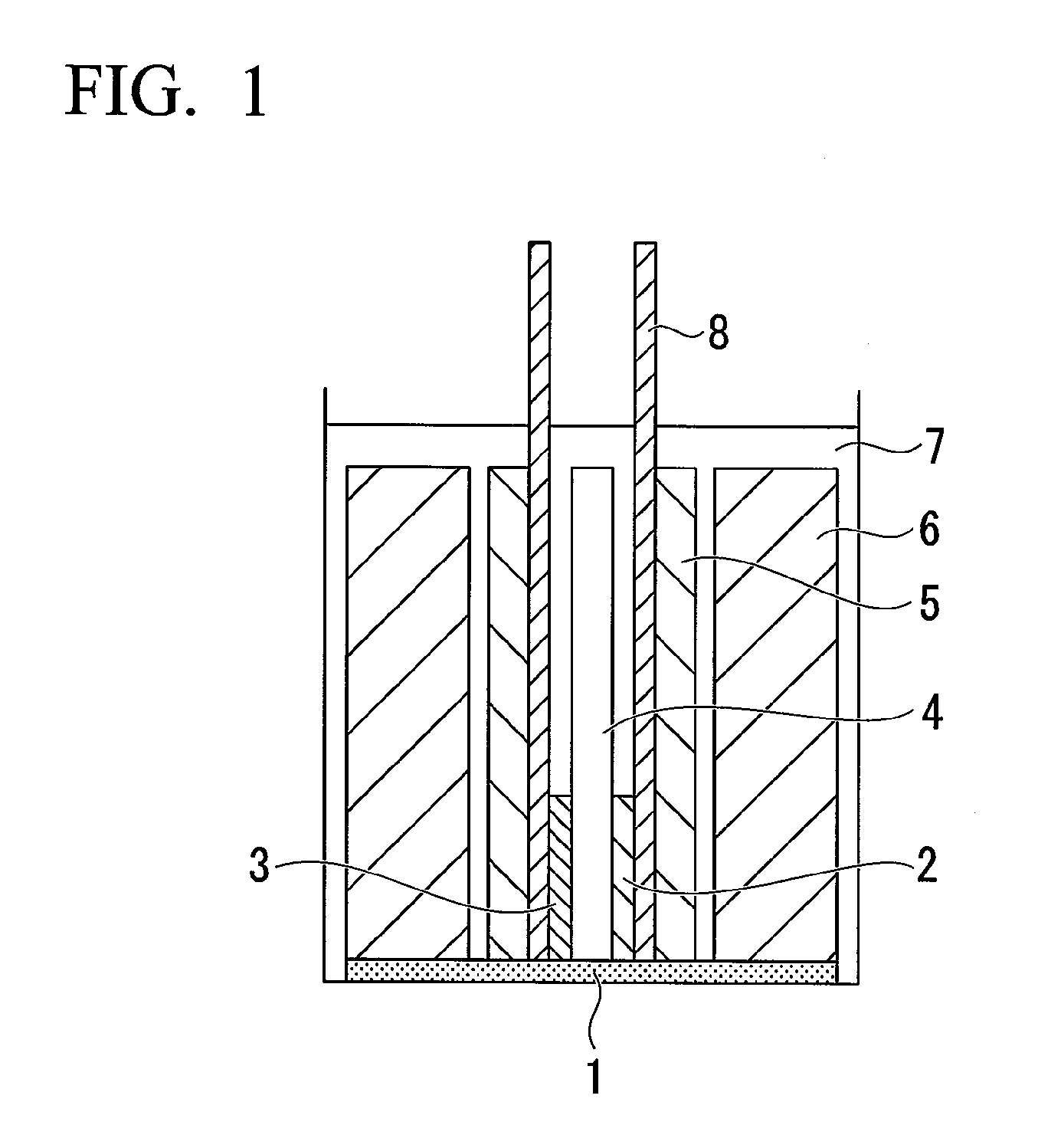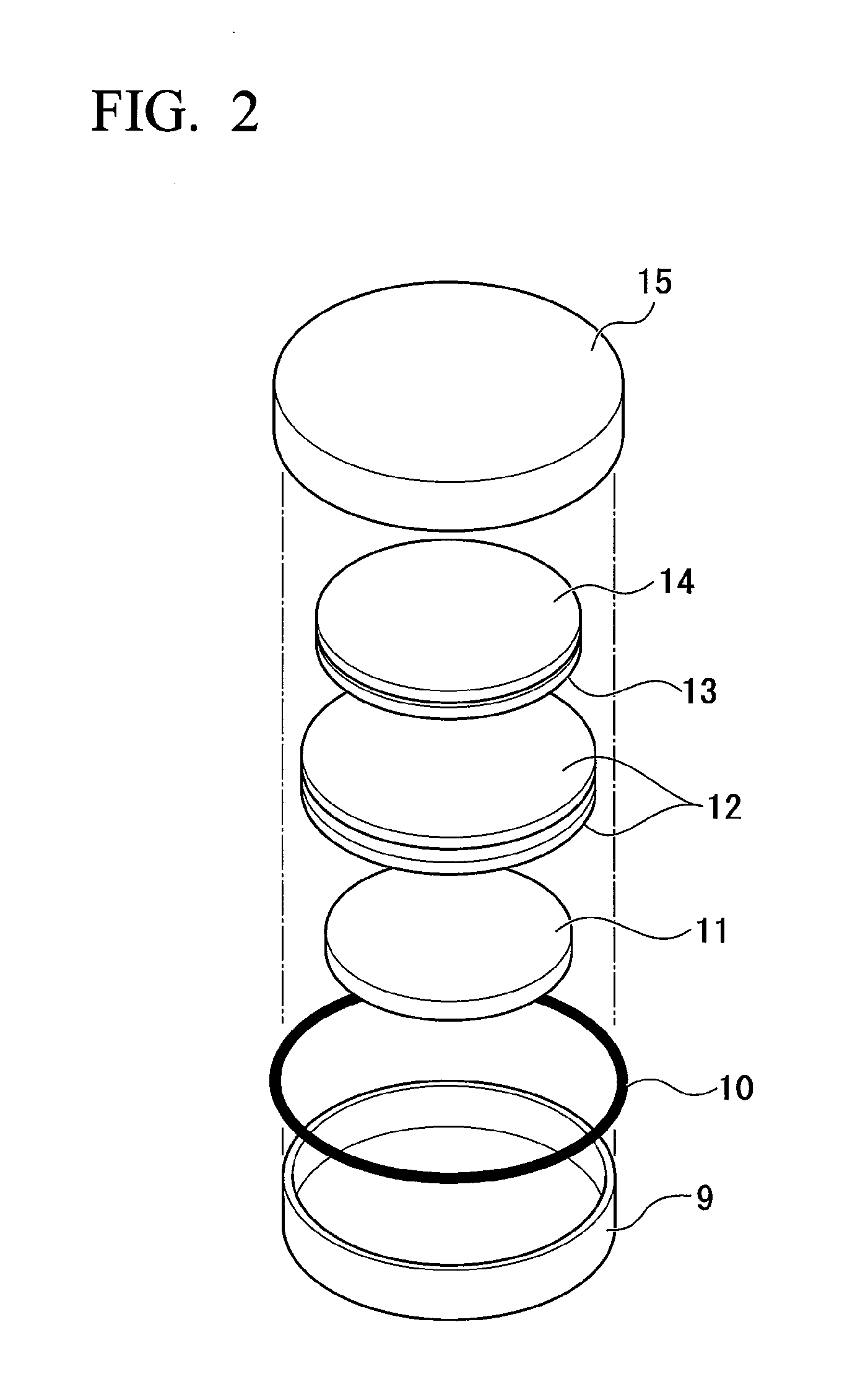Porous Silicon-Containing Carbon-Based Composite Material, Electrode and Battery Formed Therefrom
a composite material and porous silicon technology, applied in silicon compounds, cell components, electrochemical generators, etc., can solve the problems of short circuit between positive and negative electrodes, reduced charge and discharge cycle life, etc., to achieve stable charge and discharge cycle characteristics, reduce potential loss, and high reversible capacity
- Summary
- Abstract
- Description
- Claims
- Application Information
AI Technical Summary
Benefits of technology
Problems solved by technology
Method used
Image
Examples
example 1
Preparation of a Precursor Polymer of a Silicon-Containing Carbon-Based Composite Material
[0161]3.0 parts by weight of a polysilane (weight average molecular weight (hereinafter, referred to as Mw)=1.03×103) represented by the average unit formula:
(Ph2Si)0.85(PhSi)0.15
[0162]3.0 parts by weight of polystyrene beads manufactured by Wako Pure Chemical Industries, Ltd., (softening point=240° C., average degree of polymerization=2,000), and 20 parts by weight of toluene with a special grade manufactured by Wako Pure Chemical Industries, Ltd., were placed in a round-bottomed flask made of glass, followed by mixing for one hour at 100° C. at normal pressure to dissolve the mixture. Subsequently, toluene was removed by distillation under reduced pressure. Thereby, a precursor polymer of a silicon-containing carbon-based composite material was prepared.
[0163]Preparation of a Silicon-Containing Carbon-Based Composite Material
[0164]5.0 parts by weight of the aforementioned precursor polymer w...
example 2
Preparation of a Precursor Polymer of a Silicon-Containing Carbon-Based Composite Material
[0169]5.0 parts by weight of a polysilane (Mw=1.03×103) represented by the following average unit formula:
(Ph2Si)0.85(PhSi)0.15
[0170]5.0 parts by weight of coal tar pitch (softening point=143° C.; High Pellet, manufactured by Osaka Kasei Co., Ltd.), 0.6 parts by weight of 2,5-dimethyl-2,5-di(t-butylperoxy)hexane, and 50 parts by weight of tetrahydrofuran with a special grade were placed in a two-necked flask equipped with a stirrer, and the mixture was stirred for 30 minutes at normal pressure. Subsequently, tetrahydrofuran was removed by distillation under reduced pressure. Subsequently, a reflux condenser and a thermometer were fixed to the flask. Subsequently, the reaction mixture was subjected to a heat treatment for 30 minutes at 200° C. with a nitrogen flow. Thereby, a precursor polymer of a silicon-containing carbon-based composite material was prepared.
[0171]Preparation of a Silicon-Co...
example 3
Preparation of a Precursor Polymer of a Silicon-Containing Carbon-Based Composite Material
[0177]15.00 parts by weight of a polysilane (Mw=1.03×103) represented by the following average unit formula:
(Ph2Si)0.85(PhSi)0.15
[0178]15.77 parts by weight of polystyrene beads manufactured by Wako Pure Chemical Industries, Ltd., (softening point=240° C., average degree of polymerization=2,000), and 95 parts by weight of toluene with a special grade manufactured by Wako Pure Chemical Industries, Ltd., were placed in a round-bottomed flask made of glass, followed by mixing for one hour at 100° C. at normal pressure to dissolve the mixture. Subsequently, toluene was removed by distillation under reduced pressure. Thereby, a precursor polymer of a silicon-containing carbon-based composite material was prepared.
[0179]Preparation of a Silicon-Containing Carbon-Based Composite Material
[0180]13.00 parts by weight of the aforementioned precursor polymer was placed in a boat made of alumina with an SS...
PUM
| Property | Measurement | Unit |
|---|---|---|
| temperature | aaaaa | aaaaa |
| melting point | aaaaa | aaaaa |
| particle size | aaaaa | aaaaa |
Abstract
Description
Claims
Application Information
 Login to View More
Login to View More - R&D
- Intellectual Property
- Life Sciences
- Materials
- Tech Scout
- Unparalleled Data Quality
- Higher Quality Content
- 60% Fewer Hallucinations
Browse by: Latest US Patents, China's latest patents, Technical Efficacy Thesaurus, Application Domain, Technology Topic, Popular Technical Reports.
© 2025 PatSnap. All rights reserved.Legal|Privacy policy|Modern Slavery Act Transparency Statement|Sitemap|About US| Contact US: help@patsnap.com



